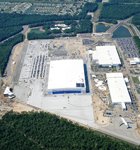At a Glance
Location
New York City
Founded
2004
Employees
17
Specialties
Interior architecture and design
According to the senior principals at Applied Design Initiative, LLC (ADI), a New York-based consulting firm specializing in interior architecture and design, none of them ever expected to found his or her own company. As the three designers together climbed the ranks at a large national firm, though, they agreed that some essential part of their professional enjoyment had fallen away. And they wanted that part back.
“As you get executive-level responsibilities,” senior principal Jay Lubow says, “you get taken further away from projects. We missed that involvement.” His partners, Robert Heizler and Nancy Ann Weintraub, agree. “We run our company differently,” Heizler says, pointing to duties such as paper-pushing as particularly destructive forces against creativity. “We minimize the overhead—the spreadsheets, etc.—that takes [creative talents] away from their purposes.”
It’s a sensible idea, allowing staff members to do what they do best, and it’s one with quantifiable results, too: the majority of ADI’s 17 full-time employees are colleagues who followed from the principals’ previous firm; only the administrative staff and three architecture/design associates were hired from outside this close-knit cohort. Also, notably, ADI didn’t let a single person go during the economic downturn. Such familiarity tends to breed trust and devotion among the staff.
Top 5 Interior Elements of the Wall Street Journal Media Center
1. A LED-backlit, color-customizable media wall—10 feet in height and featuring a 60-inch floating flat-screen monitor—dominates the open-ceiling reception space.
2. An inverted conical element with recessed light boxes displays the history of Dow Jones & Company.
3. Glass-fronted offices, low-energy, high-output lay-in lighting, and a collaborative work environment give the space an open, airy feel.
4. Three walk-up monitors with keyboards allow visitors to explore the company website.
5. Floating glass shelves highlight the firm’s hard-copy marketing materials.
These humanistic principles extend to ADI’s larger approach. The firm’s most fundamental principle is a focus on client relationships, and ADI considers the bulk of its business as account-based rather than project-based. The Associated Press has contracted ADI for more than 65 news bureaus, in every state except Alaska, and that account begat another for the Xinhua News Agency’s North America project, a 48-person newsroom in the heart of Times Square. WNYC Public Radio, too, retains ADI on an ongoing basis for assistance with its facility, which houses eight studios and a performance space.
The firm has long-term alliances with other high-profile companies, too, including JPMorgan Chase, DC Comics, Information Builders, and Liz Claiborne, and completed the standout Wall Street Journal Media Center. Established relationships such as these provide ADI’s associates with a cumulative knowledge of various client goals, leading to a greater understanding of how best to fulfill future needs, usually by either maintaining a client’s current image or helping to redefine it. “The firm has developed a particular expertise,” Weintraub says, “with environments that require a high degree of technical expertise.”
The firm’s commitment to personal service also explains why, in 2004, shortly after ADI was founded, Heizler received a call from a former client with a new project in mind—an 8,000-square-foot reconfiguration and facelift for the Dow Jones executive-board suite in Manhattan. It ended up being one of the company’s first works. “I think we’d been in business for about four days,” Heizler says.
Known for restacking and consolidating office space and for relocation, expansion, or renovation, ADI has done hundreds of projects totaling more than two million square feet. While corporate interiors might be considered the firm’s niche, though, retail and public projects are also part of its portfolio, including the McGoldrick Branch of the Queens Public Library. And sustainability, too, is paramount, with more than 40 percent of firm members already LEED-accredited. “What we want,” Lubow says, “is a beautiful, branded space that functions in the most efficient way possible.” This objective remains the same regardless of sector, size, or the client’s relationship with ADI. For ADI principals, this is essential. ABQ



